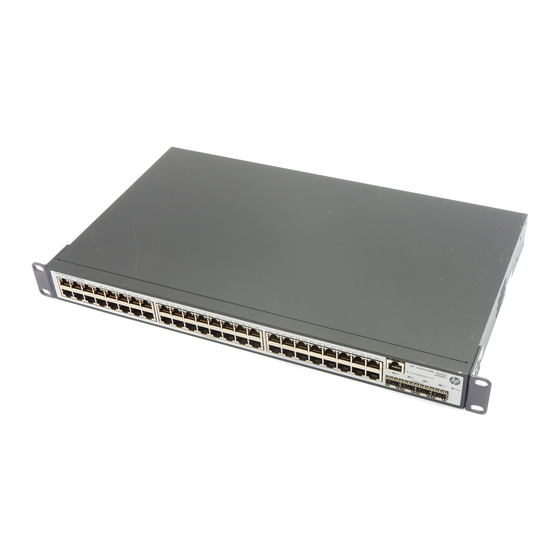HP 1910-48 Quickspecs - Strona 2
Przeglądaj online lub pobierz pdf Quickspecs dla Przełącznik HP 1910-48. HP 1910-48 43 stron. 1910 switch series
Również dla HP 1910-48: Arkusz danych (16 strony), Quickspecs (44 strony), Podręcznik dla początkujących (26 strony)

QuickSpecs
Overview
Single IP management
enables management of up to four HP 1910 devices using a single Web interface; simplifies management of multiple devices
Secure Web GUI
provides a secure, easy-to-use graphical interface for configuring the module via HTTPS
SNMPv1, v2c, and v3
facilitates management of the switch, as the device can be discovered and monitored from an SNMP management station
Complete session logging
provides detailed information for problem identification and resolution
Dual flash images
provides independent primary and secondary operating system files for backup while upgrading
Port mirroring
enables traffic on a port to be simultaneously sent to a network analyzer for monitoring
Management security
restricts access to critical configuration commands; offers multiple privilege levels with password protection; ACLs provide
telnet and SNMP access; local and remote syslog capabilities allow logging of all access
Network Time Protocol (NTP)
synchronizes timekeeping among distributed time servers and clients; keeps timekeeping consistent among all clock-dependent
devices within the network so that the devices can provide diverse applications based on the consistent time
IEEE 802.1AB Link Layer Discovery Protocol (LLDP)
advertises and receives management information from adjacent devices on a network, facilitating easy mapping by network
management applications
Limited CLI
enables users to quickly deploy and troubleshoot devices in the network
RMON
provides advanced monitoring and reporting capabilities for statistics, history, alarms, and events
Default DHCP client mode
allows the switch to be directly connected to a network, enabling plug-and-play operation; in absence of DHCP server on the
network, the switch will fallback to a unique static address determined by the MAC address of the switch
Quality of Service (QoS)
Broadcast control
allows limitation of broadcast traffic rate to cut down on unwanted network broadcast traffic
Rate limiting
sets per-port ingress enforced maximums and per-port, per-queue minimums
Traffic prioritization
provides time-sensitive packets (like VoIP and video) with priority over other traffic based on DSCP or IEEE 802.1p classification;
packets are mapped to four hardware queues for more effective throughput
Connectivity
IPv6
IPv6 host
enables switches to be managed and deployed at the IPv6 network's edge
IPv6 routing
supports IPv6 static routes
MLD snooping
forwards IPv6 multicast traffic to the appropriate interface, preventing traffic flooding
IPv6 ACL/QoS
supports ACL and QoS for IPv6 network traffic
DA - 13677 Worldwide — Version 12 — December 9, 2013
HP 1910 Switch Series
Page 2
